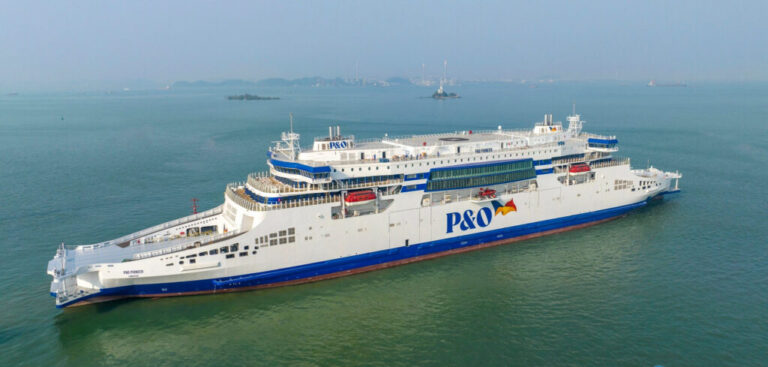Captain Simon Moore from P&O Ferries sat down with Electric & Hybrid Marine Technology International as he prepared to take over the final leg of the voyage to bring the new hybrid ferry P&O Liberté back from China to arrive in Dover on March 1, 2024, where it joined sister ship, P&O Pioneer. The two vessels are the two largest double-ended hybrid ferries in the world and can use their hybrid capacity to reduce carbon emissions by up to 40%, with the capacity for more reductions when greater shore power is available. Captain Moore has been part of the project to develop the Fusion Class of hybrid ferries since the beginning and was at the center of the task to bring Pioneer into service in 2023.
What were your thoughts as you prepared to bring the second Fusion Class vessel P&O Liberté back to the UK to begin service on the Dover-Calais route?
The period of time leading up to P&O taking delivery of the vessel in China was very intense with many aspects coming together. Upon delivery, we undertook a program of thorough crew training and systems checks to ensure the vessel was ready for the long delivery voyage via the Cape of Good Hope. It’s been great to be able to reflect on what the Ship of the Future team (the project team for the Fusion Class ferries) has achieved over the past seven years or so. From blue sky thinking to various brainstorming sessions to taking delivery of the vessels and seeing them go into service. It is a once-in-a-lifetime experience for many of the crew and I am thrilled the other masters assigned to this vessel had the opportunity to take command for some of the legs of the delivery voyage.
Do hybrid ferries cope differently with the weather in the open sea?
Being a hybrid ferry makes no difference really on the sea-keeping qualities of the vessel. What does make a difference however is the design of the hull and the Fusion Class vessels have been specifically designed for the sea conditions experienced on the Dover to Calais route.
Do the vessels fulfil what you anticipated during the Ship of the Future project?
Yes, very much so and they have also exceeded expectations! Although it is still relatively early days since the P&O Pioneer entered service, the vessel is achieving the key fundamental points upon which the business case for these ferries was based. For example, we are seeing much-improved fuel consumption, using up to 40% less fuel per crossing. Turnaround times in the Calais new port are also much improved. It is astonishing to watch the vessel discharge a full load of around 140 freight and 200 cars in just 10 minutes which is some 15 minutes quicker compared to a Spirit Class [ferry]!
What has been your experience of operating Pioneer since she went into service?
The vessel is extremely powerful and highly maneuverable. It has also been a very intensive experience learning more about what the ship can do with every maneuver. The Azipod propulsion systems are very different from our other vessels, and this takes time to master. I have been fortunate to help train some of the other masters assigned to both Pioneer and Liberté and through collaboration, we continue to learn together what this awesome machine can do.
If you started the Ship of the Future project all over again today, is there any developing technology we would take advantage of?
Huge advancements are being made in all aspects of the production of clean energy fuel cells. In time I am sure these will be scaled up to a level where they could be used on large super ferries, but they are not available yet.
Do you think it’s important to be first out with a completely new class of ferries and will we see similar hybrid vessels being delivered to other operators in time?
I firmly believe through taking calculated risks P&O has designed the next generation of super ferry for the Dover-Calais route. By having the first hybrid vessels on the route we now have a competitive advantage over the other operators for the next five years or so. There will be other hybrid vessels for sure, but I am not sure they will be as large as the Fusion Class vessels. There is new legislation such as the European ETS which now means when in European waters we are being taxed on our carbon emissions with the cost ultimately being passed down to our customers. To combat this, the next generation of vessels needs to be able to run in zero-emission mode for at least part of the European part of the voyage and preferably the whole voyage. To achieve this the ports will need to invest in shore power infrastructure, and this is unlikely to be achieved in Dover or Calais within the next five years. Importantly, the Fusion Class has been designed in a modular format so that when the infrastructure is in place the vessels can be modified by removing the generators which burn carbon-based fuels and replacing them with more batteries. Coupled with this, battery technology is advancing at an incredible rate which will only be a future benefit.
What does the pathway to decarbonizing shipping mean to you in your role?
I feel honored to have helped design and now command the most environmentally sustainable ships on the English Channel. We now operate our ships differently with a real focus on reducing our carbon footprint. With the Fusion Class, we now operate in new modes such as ‘hybrid’ and ‘zero emissions’ which is really starting to align with the goals of the pathway to decarbonizing shipping.
To find out more about P&O Ferries’ two new-build Fusion Class ferries, click here.



